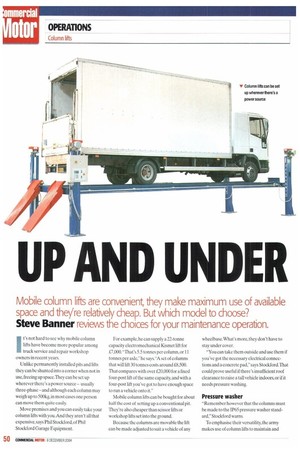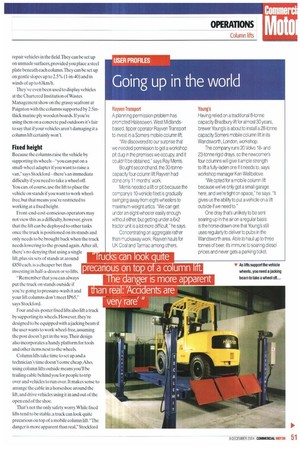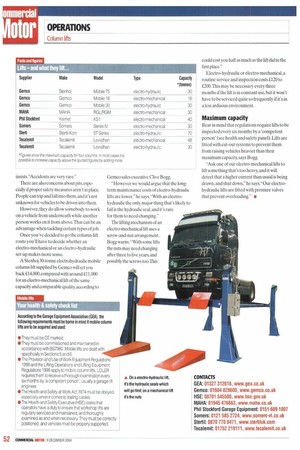UP AND UNDER
Page 52

Page 53

Page 54

If you've noticed an error in this article please click here to report it so we can fix it.
Mobile column lifts are convenient, they make maximum use of available space and theVre relatively cheap. But which model to choose? Steve Banner reviews the choices for your maintenance operation.
It's not hard to see why mobile column lifts have become more popular among truck service and repair workshop owners in recent years.
Unlike permanently installed pits and lifts they can be shunted into a corner when not in use, freeing up space.They can be set up wherever there's a power source — usually three-phase — and although each column may weigh up to 500kg, in most cases one person can move them quite easily.
Move premises and you can easily take your column lifts with you. And they aren't all that expensive, says Phil Stockford, of Phil Stockford Garage Equipment. For example, he can supply a 22-tonne capacity electromechanical Kismet lift for £7,000. "That's 5.5 tonnes per column, or 11 tonnes per wde," he says."A set of columns that will lift 30 tonnes costs around £8,500. That compares with over £20,000 for a fixed four-post lift of the same capacity, and with a four-post lift you've got to have enough space to run a vehicle onto it."
Mobile column lifts can be bought for about half the cost of setting up a conventional pit. They're also cheaper than scissor lifts or workshop lifts set into the ground.
Because the columns are movable the lift can be made adjusted to suit a vehicle of any wheelbase. What's more, they don't have to stay under cover.
"You can take them outside and use them if you've got the necessary electrical cornicetions and a concrete pad," says Stockford.That could prove useful if there's insufficient roof clearance to raise a tall vehicle indoors, or if it needs pressure washing.
Pressure washer
"Remember however that the columns must be made to the 1P65 pressure washer standard," Stockford warns.
To emphasise their versatility, the army makes use of column lifts to maintain and repair vehicles in the field.They can be set up on unmade surfaces,provided you place a steel plate beneath each column.They can be set up on gentle slopes up to 2,5% (I -in-40) and in winds of up to 63km/h.
They've even been used to display vehicles at the Chartered Institution of Wastes Management show on the grassy seafront at Paignton with the columns supported by 2.5inthick marine ply wooden boards. If you're using them on a concrete pad outdoors it's fair to say that if your vehicles aren't damaging it a column lift certainly won't.
Fixed height
Because the columns raise the vehicle by supporting its wheels —"you can put on a small-wheel adapter if you want to raise a van," says Stockford —there's an immediate difficulty if you need to take a wheel off. You can, of course, use the lift to place the vehicle on stands if you want to work wheelfree, hut that means you're restricted to working at a fixed height.
Front-end-cost-conscious operators may not view this as a difficulty, however, given that the lift can be deployed to other tasks once the truck is positioned on its stands and only needs to be brought back when the truck needs lowering to the ground again. After all, there's no denying that using a single lift, plus six sets of stands at around £850 each, is a cheaper bet than investing in half-a-dozen or so lifts.
"Remember that you can always put the truck on stands outside if you're going to pressure-wash it and your lift columns don't meet 1P65," says Stockford.
Four and six-poster fixed lifts also lift a truck by supporting its wheels.However,they're designed to be equipped with a jacking beam if the user wants to work wheel-free, assuming the post doesn't get in the way.Their design also incorporates a handy platform for tools and other items next to the wheels.
Column lifts take time to set up and a technician's time doesn't come cheap.Also, using column lifts outside means you'll be trailing cable behind you for people to trip over and vehicles to run over. It makes sense to arrange the cable in a horseshoe around the lift, and drive vehicles using it in and out of the open end of the shoe.
That's not the only safety worry. While fixed lifts tend to be stable, a truck can look quite precarious on top of a mobile column lift. "The danger is more apparent than real," Stockford insists."Accidents are very rare."
There are also concerns about pits, especially if proper safety measures aren't in place. People can trip and fall into them, and it's not unknown for vehicles to be driven into them.
However, they do allow somebody to work on a vehicle from underneath while another person works on it from above.That can be an advantage when tackling certain types of job.
Once you've decided to go the column-lift route you'll have to decide whether an electro-mechanical or an electro-hydraulic set-up makes more sense.
A Stenhoj 30-tonne electrohydraulic mobile column lift supplied by Gemco will set you back £14,000, compared with around £11,000 for an electro-mechanical lift of the same capacity and comparable quality,according to Gemco sales executive (Jive Bogg.
"However we would argue that the longterm maintenance costs of electro-hydraulic lifts are lower," he says. "With an electrohydraulic the only major thing that's likely to fail is the hydraulic seal, and it's rare for them to need changing."
The lifting mechanism of an electro-mechanical lift uses a screw-and-nut arrangement. Bogg warns: "With some lifts the nuts may need changing after three to five years, and possibly the screws too.This could cost you half as much as the lift did in the first place."
Electro-hydraulic or electro-mechanical, a routine service and inspection costs £120 to £200.This may be necessary every three months if the lift is in constant use, but it won't have to be serviced quite so frequently if it's in a less arduous environment.
Maximum capacity
Bear in mind that regulations require lifts to be inspected every six months by a 'competent person' (see health and safety panel). Lifts are fitted with cut-out systems to prevent them from raising vehicles heavier than their maximum capacity, says Bogg.
"Ask one of our electro-mechanical lifts to lift something that's too heavy, and it will detect that a higher current than usual is being drawn. and shut down," he says. "Our electrohydraulic lifts are fitted with pressure valves that prevent overloading." •


























































































































































































